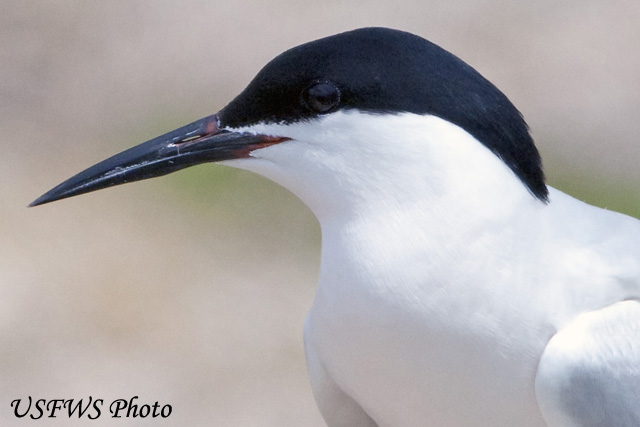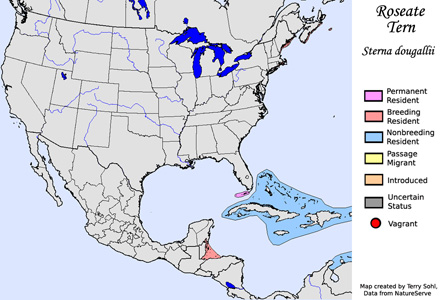| Length: 12.5 inches | Wingspan: 28 inches | Seasonality: Non-resident in South Dakota |
| ID Keys: Thin black bill, dark cap and forehead (breeding), white forehead (non-breeding), deeply forked white tail | ||
 The
Roseate Tern is a bird with a worldwide distribution, found on every
continent except Antarctica. In North America, they are found in a few
spots on the Atlantic coast, with most birds either in New England, or in
Florida. They are only summer breeding residents in North America,
with nearly all birds moving south to the Caribbean or to South America for
the winter. They can appear similar to other tern species, most
notably the Common Tern and
Forster's Tern, but the long, thin
black bill is an easy ID characteristic if the bird is seen well.
The
Roseate Tern is a bird with a worldwide distribution, found on every
continent except Antarctica. In North America, they are found in a few
spots on the Atlantic coast, with most birds either in New England, or in
Florida. They are only summer breeding residents in North America,
with nearly all birds moving south to the Caribbean or to South America for
the winter. They can appear similar to other tern species, most
notably the Common Tern and
Forster's Tern, but the long, thin
black bill is an easy ID characteristic if the bird is seen well.
Habitat: Found on islands with some plant cover during the nesting season, usually in areas with significant expanses of shallow water for foraging. Outside of the breeding season, found in warmer waters, usually near shore, but sometimes far out to sea.
Diet: Feeds mostly on small fish, but will also sometimes eat small crustaceans, mollusks, or other small marine creatures.
Behavior: Feeds by flying above the water and then plunging down when prey is spotted. They will also sometimes maintain flight and dip down and grab prey from the water's surface.
Nesting: The nest of a Roseate Tern is a shallow scrape on the ground, usually placed near cover such as a rock or vegetation, and lined with bits of plant and other debris. The female usually lays 1 or 2 eggs, and both parents help to incubate them. After the eggs hatch, both parents help to feed the young.
Song: Calls are crisp and harsh-sounding with two notes. Also has several other calls and alarm notes.
Migration: Those in North America are migratory, with birds along the Atlantic Coast heading to the Caribbean and northern coast of South America for the Winter. Some birds in the Florida Keys may remain all year long, with nearly all of those younger birds.
Interactive eBird Map: Click here to access an interactive eBird map of Roseate Tern sightings
Similar Species: In range in North America, most likely to be confused with Forster's Tern, Common Tern, or Sandwich Tern
Conservation Status: Populations are very widespread, and global populations are strong. The IUCN lists the Roseate Tern as a species of "Least Concern".
Further Information: 1) U.S. Fish and Wildlife Species Profile - Roseate Tern
2) New York State Department of Environmental Conservation - Roseate Tern Fact Sheet
3) Audubon Guide - Roseate Tern
Photo Information: Photo from U.S. Fish and Wildlife Service - August 5th, 2010 - Hong Kong - Photo licensed under Creative Commons Attribution 2.0 Generic License
| Click below for a higher-resolution map |
 |
| South Dakota Status: Non-resident in South Dakota |
Additional Roseate Tern Photos (coming soon!!)
